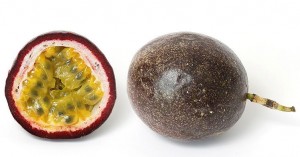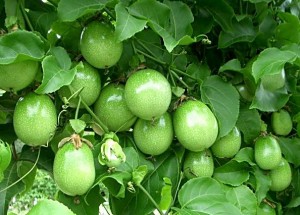 Passionfruit (Passiflora edulis), is a vine edible fruit of the passion flower that is native to Paraguay, Brazil and northeastern Argentina. The passion fruit is round to oval, yellow or dark purple at maturity, with a soft to firm, juicy interior filled with numerous seeds. The fruit can be grown to eat or for its juice, which is often added to other fruit juices to enhance the aroma. For eating right out of the fruit, allow the fruit to wrinkle for a few days to raise the sugar levels and enhance the flavor.
Passionfruit (Passiflora edulis), is a vine edible fruit of the passion flower that is native to Paraguay, Brazil and northeastern Argentina. The passion fruit is round to oval, yellow or dark purple at maturity, with a soft to firm, juicy interior filled with numerous seeds. The fruit can be grown to eat or for its juice, which is often added to other fruit juices to enhance the aroma. For eating right out of the fruit, allow the fruit to wrinkle for a few days to raise the sugar levels and enhance the flavor.
There are two types of passion fruit, purple passion fruit and yellow passion fruit, which differ in appearance but taste the same. The bright yellow variety of passion fruit, which is also known as the Golden Passion Fruit, can grow up to the size of a grapefruit, has a smooth, glossy, light and airy rind. The dark purple passion fruit is smaller than a lemon.
Passion fruit by itself tends to taste tart. It is usually used with other types of fruit in recipes to lighten its tangy taste. Passion fruit, as well as its flower, are known for their aromatic scent. Because of its sweet smelling fragrance, passion fruit is sometimes added to food simply to enhance its aroma. It is popular in gourmet cooking. It is used in many desserts and jams and it is also used in main dishes. Juice, punch, liqueurs and cocktails have a tropical flair when made with passion fruit.
Passion fruit has hundreds of medicinal properties that have been used throughout history. The natural chemicals in passion fruit are used to lower blood pressure, control spasms and treat asthma. The fruit and its leaves also work as a sedative, helping to induce sleep and calm nervousness or other mood disorders. Modern science has observed that passion fruit extracts can kill cancer cells in developing fetuses. Passion fruit is also thought to expel worms, kill bacteria and enhance the libido.
How to grow Passionfruit
DESCRIPTION
Growth Habit
The passion fruit is a vigorous, climbing vine that clings by tendrils to almost any support. It can grow 15 to 20 ft. per year once established and must have strong support. It is generally short-lived (5 to 7 years).
Foliage
The evergreen leaves of passion fruit are alternate, deeply 3-lobed when mature and finely toothed. They are 3 to 8 inches long, deep green and glossy above, paler and dull beneath and, like the young stems and tendrils, tinged with red or purple, specially in the yellow form.
Flowers
A single, fragrant flower, 2 to 3 inches wide, is born at each node on the new growth. The bloom, clasped by 3 large, green, lifelike bracts, consists of 5 greenish-white sepals, 5 white petals and a fringelike corona of straight, white-tipped rays, rich purple at the base. It also has 5 stamens with large anthers, the ovary and triple-branched style forming a prominent central structure. Purple passion fruit is self-fruitful, but pollination is best under humid conditions. The flowers of the yellow form are perfect but self-sterile. Carpenter bees are the most efficient pollinator, much more so than honey bees. Wind is ineffective because of the heaviness and stickiness of the pollen. The flowers can also be hand pollinated.
Fruit
The nearly round or ovoid fruit, 1-1/2 to 3 inches wide, has a tough rind that is smooth and waxy and ranging in hue from dark purple with faint, fine white specks, to light yellow or pumpkin-color. Within is a cavity more or less filled with an aromatic mass of double walled, membranous sacs containing orange-colored, pulpy juice and as many as 250 small, hard, dark brown or black, pitted seeds. The unique flavor is appealing, musky, guava-like and sweet/tart to tart. The yellow form has generally larger fruit than the purple, but the pulp of the purple is less acid, richer in aroma and flavor, and has a higher proportion of juice (35-38%). Numerous hybrids have been made between purple and the yellow passion fruit, often yielding colors and other characteristic intermediate between the two forms. The vine, especially the yellow form, is fast-growing and will begin to bear in 1 to 3 years. Ripening occurs 70 to 80 days after pollination.
CULTIVARS
- Black Knight
- Edgehill
- Frederick
- Kahuna
- Paul Ecke
- Red Rover
- Brazilian Golden
- Golden Giant
CULTURE

Location
Plant passion fruit vines in full sun except in very hot areas where partial shade is preferable. The vine can be rather rampant, so it is important to plant it next to a chain link fence or install a strong trellis before planting. The plants can also be trained into an attractive arbor.
Soil
Passion fruit vines grow on many soil types but light to heavy sandy loams with a pH of 6.5 to 7.5 are the most suitable. Excellent drainage is absolutely necessary. Also, the soil should be rich in organic matter and low in salts. If the soil is too acid, lime must be applied. Because the vines are shallow-rooted, they will benefit from a thick layer of organic mulch.
Irrigation
Regular watering will keep a vine flowering and fruiting almost continuously. Water requirement is high when fruits are approaching maturity. If the soil is dry, fruits may shrivel and fall prematurely.
Fertilization
Passion fruit vines are vigorous growers and require regular fertilizing. A good choice is 10-5-20 NPK applied at the rate of 3 pounds per plant 4 times a year. Too much nitrogen results in vigorous foliage growth at the expense of flowering. Passion fruit vines should always be watched for deficiencies, particularly in potassium and calcium, and of less importance, magnesium. Plants that have been damaged by frost should receive a generous fertilizing after the weather has warmed
Pruning
Pruning is necessary to keep the vines within bounds, to make harvest easier and to keep the plants productive by maintaining vigorous growth. In warm winter climates prune immediately after harvest. In areas with cool winters prune in early spring. As a a general rule remove all weak growth and cut back vigorous growth by at least one third. In very hot climates allow a thick canopy of foliage to grow around the fruit to prevent sunburn.
Propagation
Passion fruit vines are usually grown from seeds. With the yellow form seedling variation provides cross-pollination and helps overcome the problem of self-sterility. Seed planted soon after removal from the fruit will germinate in 10 to 20 days. Cleaned and stored seeds have a lower and slower rate of germination. Seeds should be planted 1/2 to 1 inch deep in beds, and seedlings may be transplanted when 10 inches high. If taller (up to 3 feet), the tops should be cut back and the plants heavily watered.
Plants can also be propagated by layers or cuttings of matured wood with 3 to 4 nodes. Rooting may be hastened by hormone treatment. Cuttings should be well rooted and ready for setting out in 90 days. Grafting is an important means of perpetuating hybrids and reducing nematode damage and diseases by utilizing the resistant yellow passion fruit rootstock. Scions of healthy young plants are grafted to seedlings, making sure the diameter of the scion matches that of the rootstock. Either a cleft graft, whip graft or side-wedge graft may be made.
Pests and Diseases
In tropical areas passion fruit vines are attacked by a host of pests and diseases. In these areas the purple passion fruit is particularly susceptible to nematodes, while the yellow passion fruit is more nematode resistant. In California the problems are much less severe, although the plants can be afflicted with nematodes and viruses as well as Fusarium and other diseases that thrive in cool soils. Nematodes are partially responsible for the short life of many passion fruit vines. Snails can also be a serious problem in California, often completely stripping a vine of leaves and bark, killing young plants or predisposing them to disease.
Harvest
The fruit will quickly turn from green to deep purple (or yellow) when ripe and then fall to the ground within a few days. They can either be picked when they change color or gathered from the ground each day. To store passion fruit, wash and dry them gently and place them in bags. They should last 2 to 3 weeks at 50° F. The fruit is sweetest when slightly shriveled. Both the fruit and the juice freeze well. The flavor of passion fruit blends well with citrus and many other fruit flavors, and is quickly appreciated by many people as they become familiar with it.
Food Uses
The fruit is of easy preparation. One needs only cut it in half lengthwise and scoop out the seedy pulp with a spoon. For home use, Australians do not trouble to remove the seeds but eat the pulp with cream and sugar or use it in fruit salads or in beverages, seeds and all. Elsewhere it is usually squeezed through two thicknesses of cheesecloth or pressed through a strainer to remove the seeds. Mechanical extractors are, of course, used industrially. The resulting rich juice, which has been called a natural concentrate, can be sweetened and diluted with water or other juices (especially orange or pineapple), to make cold drinks.
Passionfruit juice can be boiled down to a syrup which is used in making sauce, gelatin desserts, candy, ice cream, sherbet, cake icing, cake filling, meringue or chiffon pie, cold fruit soup, or in cocktails. The seeded pulp is made into jelly or is combined with pineapple or tomato in making jam. The flavor of passionfruit juice is impaired by heat preservation unless it is done by agitated or “spin” pasteurization in the can. The frozen juice can be kept without deterioration for 1 year at 0º F (-17.78º C) and is a very appealing product.
Sources: www.crfg.org, www.hort.purdue.edu, wisegeek.com; Photos: Wikipedia.com, www.passionfruit.com.au